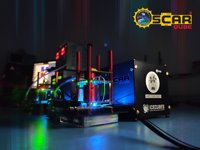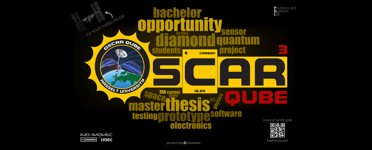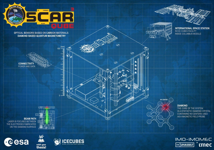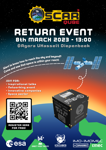OSCAR-QUBE aboard space station ISS
Welcome to the webpage of OSCAR-QUBE, an interdisciplinary student project aiming at the development of the next generation of magnetic field sensors based on NV centers in diamond and quantum operating principles. Here you can find all information about our space mission and the years of work to achieve it.


View the content of this page

Join the TEAM now!
As the new academic year begins, new opportunities arise! Are you ready to be part of something bigger? Do you have a passion for space, science, or engineering? Would you like to contribute to a real application that will be tested in space? How about working on a technology that can change the way we see the world around us? If you’ve answered “yes” to any of these questions, please don’t hesitate to get in touch with us today!
For whom is this opportunity?
Motivated bachelor or master students at Hasselt University!
The project is mainly extracurricular, and can be undertaken on a voluntary basis, for lifelong learning (LLL), or even for project+ credits. Additionally, there are possibilities to extend your involvement through a bachelor or master thesis, or another suitable course. By dedicating your time, you'll take part in every phase of a space project, from its initial idea phase to operation and data processing. You'll gain practical skills in proposal writing and documentation, critical thinking, design, development, and publishing. Joining the team will provide you with the opportunity to experience the full lifecycle of a space project!
What will you gain?
By being part of the journey, you will gain:
- Invaluable experience and personal growth
- Soft skills: communication, teamwork, giving and receiving feedback, creativity, independence, self-realization, academic writing, public speaking, presentation skills, and time management
- Technical skills: Get familiar with space standards (designing, assembling, manufacturing requirements), hands-on experience, learn how to implement theoretical concepts into practical implementation
- Dealing, working, and adhering to requirements
- Position in an interdisciplinary team
- Meet people with a similar interest and mind-set
- Get in touch with the Belgian and European space sector
Where are we located?
We have a laboratory space at IMO-IMOMEC (Wetenschapspark 1), where you will be able to work together with the rest of the team. Here you will have the facilities, tools, and freedom to explore and experiment in a creative environment.
What are we looking for?
For motivated students who are willing to learn more by doing. Below are listed the roles and typical tasks associated with it. As the participation to the project is voluntary, you can choose the area you want to expand your knowledge on - so you are free to grow.
- Electronics - Design, simulation, assembly and manufacture, soldering, testing
- Mechanical - CAD, 3D drawing, FEM analysis, 3d printing prototyping, assembly
- Software - Software design, Embedded programming, C/C++, FreeRTOS, Python
- Science - Experimental, Optics design, magnetism, quantum
- Analysis and testing - Environmental and functional testing, reliability testing, concept testing, mission analysis
- Outreach - come up with and prepare social media posts, help spread the project to a wider audience, internal and external media
Didn’t find yourselves fitting in one of these profiles, but you are still interested in being part of the team? Don’t worry, the possibilities are open for everyone! Feel free to reach out, so we can explore the possibilities.
How to get in contact with us?
It’s very easy, send us an email with your motivation and which field interests you the most, and we will continue from there.

Who are we?
We are team OSCAR-QUBE, an interdisciplinary team of UHasselt students and the research institute imo-imomec (UHasselt & imec). It consists of very different disciplines: bachelors, masters and PhDs, engineers and physicists. For years, our mission has been to bring quantum sensing directly from the lab to space. On August 28 2021, it finally happened. Aboard the SpaceX CRS 23, our diamond-based quantum magnetometer has departed for the ISS space station. The OSCAR-QUBE project was developed as a topic that is addressed within the Quantum Science & Technology research domain.
Frequently asked questions
What do we do?
What do we do?
During the third iteration of the OSCAR project (see also 'how OSCAR-QUBE came to be'), we developed a diamond-based quantum magnetometer to map magnetic fields. The European Space Agency, ESA, selected OSCAR-QUBE within their “Orbit Your Thesis!” project to be given a place aboard the space station ISS. From here, our magnetometer will map the magnetic field around the Earth in 3D for 10 months.
How does our technology work?
How does our technology work?
Our technology works like a compass. The magnetometer detects magnetic fields. But unlike the compass, our device does this in three dimensions and with a very high resolution and wide dynamic range.
Furthermore, it works based on two techniques where we use both an optical and an electronic way of measurement.
In the optical way, we shine a green laser on the diamond. This then gives us back a red light. We detect here from the brightness, while subjecting our diamond to microwaves. The changes in brightness that result are crucial in determining the magnetic field that surrounds the sensor.
Secondly, the photoelectric part, the green laser shines on the diamond and it is still exposed to microwaves. In this technique, however, we are not going to optically observe how bright the red light is that the diamond produces. We are rather looking at current differences that can be measured across the diamond. So here the current is crucial for us experiments we can derive the magnetic field from this.
What do we do on board the ISS?
What do we do on board the ISS?
Aboard the space station ISS, we will perform measurements for 10 months [VT1].
We measure the magnetic field of the earth and solar storms that occur.
How was OSCAR-QUBE created?
How was OSCAR-QUBE created?
The QUBE itself was designed and built from scratch. It started as an idea that was based on the experience from the previous iterations OSCAR and OSCAR-QLITE. The first thing to do was to make a long list of all the requirements the device had to fulfil. Going from the scientific requirements all the way to safety requirements in order to not pose a danger for the crew onboard the ISS. Next step is to make a design that would meet all those requirements. After the design is finished, it has become a reality. To make this as easy as possible and to allow for the ability to work on everything separately in order to come up with a finished product that is reliable and robust, we started with a testbench. By replacing all the commercial lab equipment by our own custom build designs, we were able to finetune each individual subsystem and debug easily to correct any flaws. When each subsystem was fine tuned to satisfaction, we proceeded to combine these individual subsystems into one complete system. Further fine tuning steps followed together with a lot of testing to get to a reliable and robust device. It was not only important to test the functionality of the QUBE, but also if we are compatible with the requirements that were imposed by ESA for it to be safe for the ISS crew. These tests included a vibration test to make sure we would survive the ride on the rocket, EMI/EMC test to make sure we were not going to disturb any equipment and many more which we all passed. So after the OSCAR-QUBE test campaign was completed, it was time to wrap it up for shipping and wave goodbye as it went off to Kennedy Space Center for payload integration.
How can I be part of the journey?
How can I be part of the journey?
Are you an UHasselt student? Are you interested in being part of the team and learning more hands-on and soft-skills? If quantum science or space engineering excites you, and you want to obtain experience with research and development of a real application, don't hesitate to contact us!
Would you like to support our student project? Or are you interested in how the technology we are developing can benefit your use-case? Please feel free to contact us via the email below!
Interesting links
The OSCAR-QUBE team always strives for new quantum-based applications with groundbreaking potential. Follow us on social media and get to know more about our activities.
Would you like to discuss a new opportunity or get in touch with us? Do not hesitate to contact us.
Contact
Jaroslav Hruby

Wetenschapspark 1, 3590 Diepenbeek, Belgium
OSCAR-QUBE team leader
imo-imomec

Wetenschapspark 1,3590 Diepenbeek, Belgium























